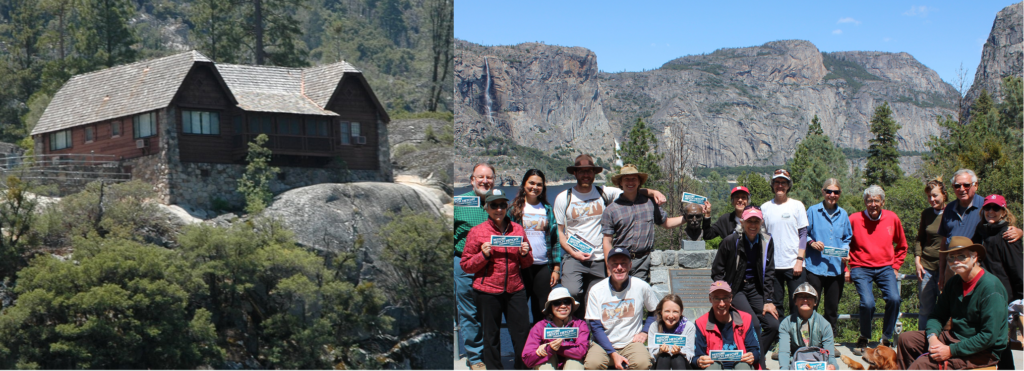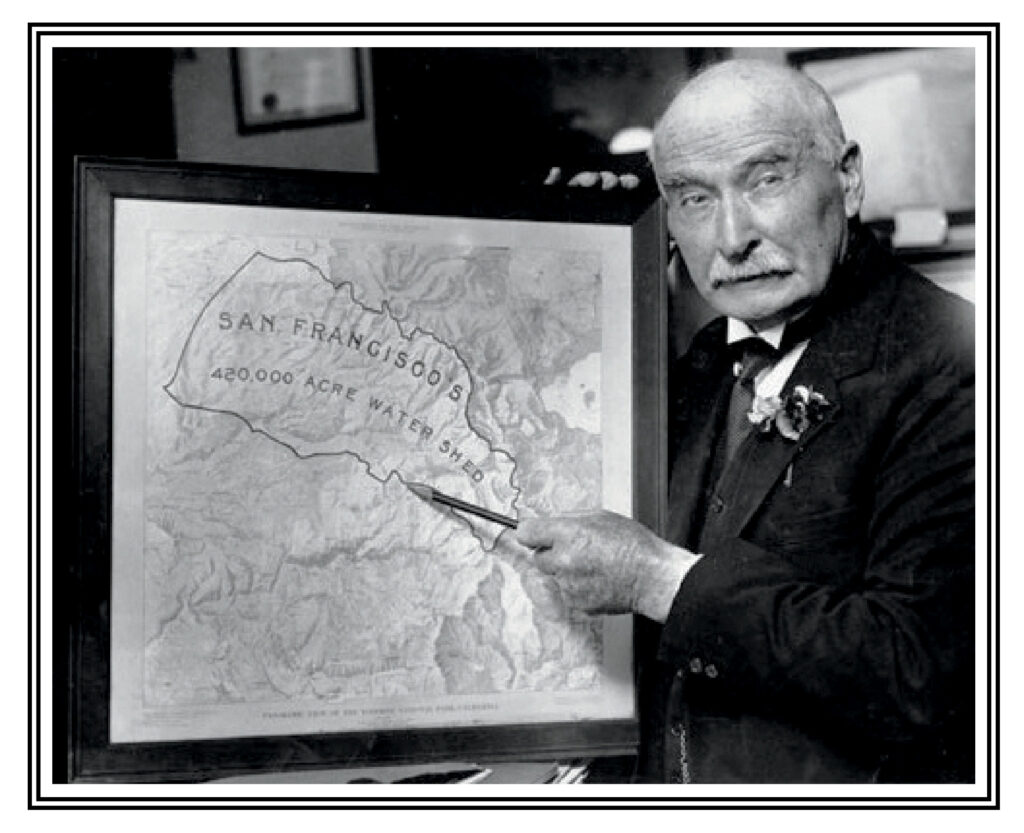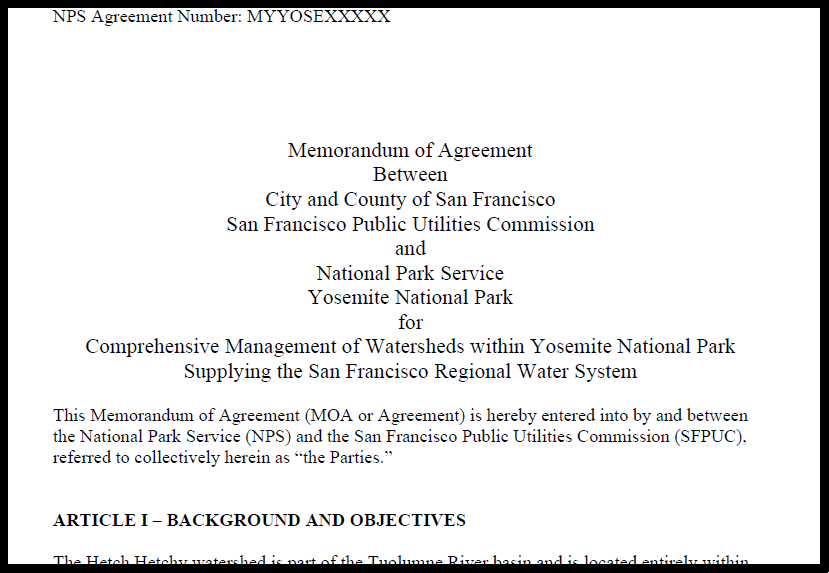
Only privileged guests of San Francisco are allowed to stay at the Hetch Hetchy “chalet” and its adjacent cabins, but its deck has provided a nice photo op for Restore Hetch Hetchy events.
The board, staff and supporters of Restore Hetch Hetchy are united by a common thread. We love Yosemite National Park – all of it, and we are committed to returning Hetch Hetchy Valley to its natural splendor. Moreover, Hetch Hetchy can be a new kind of national park, with limited development, an improved visitor experience, shared stewardship with native peoples, and permanent protection of its natural and cultural heritage for future generations.
San Francisco, collectively as a city and especially its Public Utilities Commission, loves Hetch Hetchy as well, but in a very different way. Its love goes back more than a century to its decades-long struggle to build a dam and reservoir. Ever since winning that battle, San Francisco has developed a sense of ownership of the Hetch Hetchy area and beyond – see, for example, the offering of lodging to City elites at cabins adjacent to the reservoir.

The Tuolumne River watershed covers more than one half of Yosemite National Park. Engineer Michael Maurice O’Shaughnessy describes it as belonging to San Francisco.
The National Park Service is caught in the middle of this love triangle. Officially, NPS staff members have no position on our view that the Raker Act must be modified and Hetch Hetchy Reservoir relocated (views expressed to us privately or from retired staff are uniformly pro-restoration).
The NPS is also caught in the middle when it comes to our efforts to improve recreation and access even while the dam and reservoir are in place. We’d like to see access and recreation improved at Hetch Hetchy. San Francisco seems to like it the way it is – with minimal visitation.
Camping, better trails, lengthened gate hours, boating, and public transportation etc.) will encourage visitors to know and love Hetch Hetchy as we do and ultimately to support the campaign for restoration. Restore Hetch Hetchy is working with the NPS to make improvements in these areas, consistent with the letter and spirit of the Raker Act (see Keeping Promises, Restore Hetch Hetchy, 2021).
The NPS recognizes it has neglected Hetch Hetchy for more than a century. As we have noted, they are making improvements. The gate is open longer, potable water and sanitation will soon be available at the campground and there will be a new, safer bridge across the base of Wapama Falls. We also look forward to the repair of the boat ramp, although there is no indication at this time that boating will be allowed on Hetch Hetchy Reservoir as it is on Yosemite’s natural lakes.
Even though the NPS agrees the visitor experience at Hetch Hetchy can and should be improved, San Francisco does not share this motivation. And importantly, the NPS is financially dependent on San Francisco for a significant part of their budget. While the Raker Act requires that San Francisco only pay $30,000 per year in rent, it also mandates that San Francisco reimburse the NPS for expenses related to “security” and “watershed protection” – expected to total $10,000,000 per year. This reimbursement is codified in a “Memorandum of Understanding” between the City and Yosemite, which is expected to be renewed later this year.

It’s appropriate that the NPS and SFPUC have such an agreement. As written, however, the MOA is problematic as it deviates significantly from the water quality protections included in the Raker Act. Notable are the MOA’s references, including an entire appendix, to the San Francisco Public Utilities Commission’s filtration avoidance. Unlike virtually all urban water supply agencies, San Francisco is not required to filter the 70% of system supplies that go directly from Hetch Hetchy Reservoir to customers (these water supplies are purified with chlorine, ammonia and ultra-violet light). This filtration avoidance, permitted by the California Department of Health Services, saves San Francisco the trouble and expense of enlarging its filtration plants in Sunol and Daly City.
But the Raker Act specifically states that protecting San Francisco’s filtration exemption is not NPS’ responsibility – indeed NPS is precluded from doing so.
Raker Act Section 9(a) Fifth. If at any time the sanitary regulations provided for herein shall be deemed by said grantee insufficient to protect the purity of the water supply, then the said grantee shall install a filtration plant or provide other means to guard the purity of the water. No other sanitary rules or restrictions shall be demanded by or granted to the said grantee as to the use of the watershed by campers, tourists, or the occupants of hotels and cottages…
The proposed new MOA is indeed an improvement over the existing MOA. At our request, language directly associated with the NPS commitment to filtration exemption was modified. (The existing version states that “A goal of the (joint) Source Water Protection Program is for the Hetch Hetchy water supply to maintain its filtration avoidance designation.”, while the proposed new version states more clearly that filtration avoidance is a goal of San Francisco without any reference to NPS.)
Restore Hetch Hetchy is pleased with this improvement but we don’t think it goes far enough. While the MOA does not include visitor restrictions, we believe its overzealous deference to San Francisco’s desire to avoid the expense of filtration may also be the impetus for the many restrictions to access and recreation at Hetch Hetchy that are not explained in public documents.
Given the specific language of the Raker Act, why does this joint document warrant mention of filtration avoidance at all?
Whether or not the new MOA is adopted, we will continue to remind the NPS that they are not permitted to restrict visitor activity at San Francisco’s behest beyond the specific limited provisions of the Raker Act.
Someday, the Raker Act will be modified so San Francisco will still have access to Tuolumne River supplies, but the water will not be stored in Yosemite National Park. At that time, San Francisco will still love the Tuolumne River and we can all love Hetch Hetchy and Yosemite as they should be.
